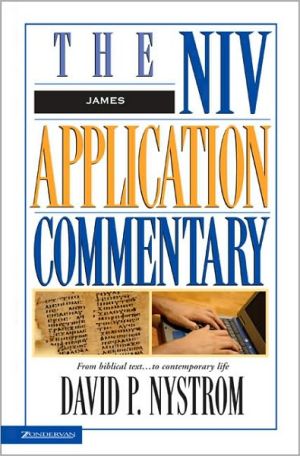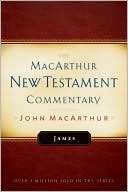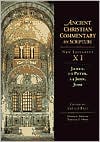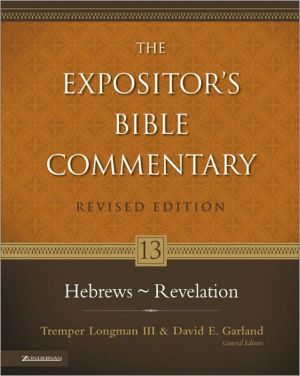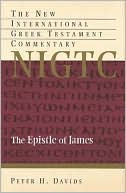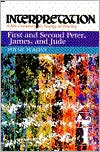Bible Commentary: NIV James
Straight to the point, practical, affirming, convicting---that's the book of James. In it, we see a picture of early Christians wrestling to apply the teachings of Jesus to their everyday lives. And we see a community plagued by divisiveness and hypocrisy, with an emphasis on wealth and status. James pulls no punches addressing these issues, calling for a faith that shows itself in moral actions: in speech, in interpersonal relationships, in economic and social justice. He also lays out a...
Search in google:
James, which is part of the NIV Application Commentary Series, helps readers learn how the message of James can have the same powerful impact today that it did when the author first wrote it.
James\ \ By David P. Nystrom \ Zondervan\ Copyright © 1997 Zondervan\ All right reserved.\ ISBN: 0-310-49360-9 \ \ \ Chapter One\ James 1:1 \ * * *\ James, a servant of God and of the Lord Jesus Christ, To the twelve tribes scattered among the nations: Greetings.\ Original Meaning\ The first century knew of many different kinds of letters. In recent years scholars have spoken of two major categories: literary letters (those written with an eye to posterity and in general marked by a concern for style) and documentary or nonliterary letters. Of course, a single letter might bear evidence of many "types" of letter writing.\ In spite of this variety, the practice of letter writing was quite conservative, for conventions changed little over time. Most letters from antiquity, and indeed most of the letters in the New Testament, can generally be seen as of a common type between individuals. These follow an established formal pattern: first, the name of the sender; then the name of the recipient; a word of greeting, usually a blessing or the expression of a desire for good health; the body of the letter; and finally the closing. The usual practice in Greek was to employ the term charein ("greetings") as the word of greeting. The typical form in Hebrew was shalom ("peace"), although among Greek-speaking Jews charein was common.\ The book of James is also a letter, but of somewhat different character. It possesses a homiletical quality and reads much like a tract or a didactic essay. This is true for at least two reasons: (1) The letter begins an exposition of its themes almost immediately, with little or no evidence of personal sentiment; and (2) the audience is essentially undetermined. Like other examples in the New Testament, James has altered the standard formula by adding theologically important terms and by including in his opening a précís of the main themes of the letter.\ The letter begins with a claim to be written by James. As we have seen, there is no viable reason to doubt that James the brother of Jesus is the source for this letter. The author wishes to emphasize several points: While he does bear authority, in character this authority is that of service, and loyalty to Jesus Christ does not in any way diminish loyalty to God.\ Servant. James refers to himself as a "servant" (doulos). There is little agreement among the commentators as to his intended meaning. Some argue that James wants to distance himself from his readers by assuming the mantle of authority. Others claim that James is interested in presenting himself as one among many brothers, with the emphasis on his authority colored by humility. Perhaps it is best to explore the full range of possibilities before determining the meaning of James's use of doulos.\ (1) Slavery. Doulos was the common Greek term for "slave," although it could also be used for "servant." Our understanding of this term is heavily and unfortunately colored by the American experience, a model that bears almost no resemblance to slavery in the Roman empire. This is true for at least two reasons. (a) Roman slavery had little if anything to do with race.\ (b) Roman slavery was far more complex than its modern manifestations, having four major types. (i) The most egregious form was slavery in the mines, normally reserved for criminals or others judged to be enemies of the Roman state. Life expectancy was low, although in spite of this we do know of cases of Christian communities providing care for Christians condemned to the mines. (ii) Next was rural slavery. The agricultural manuals of Columella, Cato, and Varro describe unenviable conditions: Work could be performed in chain gangs, family life existed at the whim of the owner, and rations could be cut to the bare minimum for slaves when they fell ill. (iii) The type of slavery that the New Testament has most often in view is urban household slavery. Here conditions also varied, but we do know of cases where persons sold themselves into slavery, counting on rewards of personal benefit. The new master provided food, shelter, and training in a skill. Many scholars believe that urban household slaves could expect manumission (a word referring to the process by which a slave was legally set free) after only a few years of service, and some argue that it was nearly automatic at the age of thirty. Manumission could be rendered under a variety of conditions, including the awarding of a sum of money to the freed person or even adoption by the master. This helps inform New Testament injunctions to slaves to "please" their masters, and perhaps even to masters to "provide your slaves with what is right and fair." (iv) The final type of slavery was imperial slavery-slaves in the household of the emperor. Some of these held positions of power and wealth second only to the emperor himself.\ (2) Old Testament. In the Old Testament the word "servant" ('ebed) is sometimes used of Israel's great heroes of the faith, and as such it is a designation of honor. Solomon concluded his prayer of dedication for the temple by referring to Moses in this way: "For you singled them [Israel] out from all the nations of the world to be your own inheritance, just as you declared through your servant Moses" (1 Kings 8:53). Second Samuel 7 is a key chapter that recounts the promise of God to establish an everlasting Davidic dynasty. The chapter describes how the Lord came to Nathan and said, "Go and tell my servant David" (2 Sam. 7:5). In a similar fashion God describes his prophets as "my servants" ( Jer. 7:25).\ Such passages demonstrate that in the Old Testament the term servant is often used of persons who are placed in positions of authority because they combine loyalty to God with humility before him. This is especially true of the "servant songs" of Isaiah 42-53. In summary, the Old Testament often describes a person or persons selected by God to bear authority as "servants." This designation indicates a humble willingness to be at God's disposal and to live according to his principles.\ It is probably beyond the range of certitude to say that James meant doulos only as a mark of authority over his readers, or only as a mark of solidarity with them. A sober judgment is that he meant something like the early church intended when, in its wisdom, it used the Latin phrase nolo episcopari as the requirement for church office: "I do not wish to be a bishop." Only those who did not desire personal power could be trusted with authority within the church. Of course, this should not be confused with a strong sense of call. The issue here is integrity and purity of motive. James is a leader because God has placed him in that role, and he has recognized and accepted it; he is not a leader because he desires personal power. James, then, speaks as one with authority, but as one with the mind of Christ, the servant of all.\ Lord and God. In this first verse James describes himself as a "servant of God and of the Lord Jesus Christ." This is an odd construction, found only here in the New Testament. Nor is it as clear as it might first appear. Some commentators have offered the following reading: "Servant of Jesus Christ, who is Lord and God." This is an intriguing hypothesis, one supported by a variety of admittedly tenuous points. Divine titles are linked elsewhere in James (1:27; 3:9). Moreover, this construction in Latin (dominus et deus) was accepted by Emperor Domitian (A.D. 81-96), a development even the Romans found both extraordinary and unsettling. They were used to granting divine status only upon the death of the emperor. Domitian was no friend to the Christians, as he allowed fierce persecution of the early church. In Christian tradition he stands with Nero as a type of anti-Christ, and seems to be so held in the view of the writer of Revelation. Certainly his apparent claim to divine status reminded readers of the "man of lawlessness" in 2 Thessalonians 2.\ The apotheosis (elevation to divine status) of the state in the person of the emperor disturbed both Jews and Christians, who together believed that only God deserved such unwavering loyalty. Both were labeled "atheists" by the Romans because they believed in only one God, not the many of Mediterranean paganism. Perhaps James used this formula to designate the one who truly is Lord and God.\ Against this position, many hold that the theology of James is too simple to have been written as late as the reign of Domitian. In any event it is still possible that James used this construction as a way of countering the claims of the Roman state. In sum, while "Jesus Christ, who is Lord and God" is a grammatical possibility, it is less likely than the traditional reading.\ James's intent here is most likely the same as in Titus 1:1-to demonstrate that loyalty to Jesus Christ does not undermine loyalty to God; that, in fact, they are one and the same. Balancing the divinity of Jesus Christ with monotheism was no small problem for early Christianity, and the formula James uses constitutes a portion of his answer to this dilemma.\ The twelve tribes. James addresses his letter to "the twelve tribes scattered among the nations." This construction is also unusual. The only parallel in the New Testament is 1 Peter 1:1. There are two main lines of interpretation available: The "twelve tribes" means Jews and/or Jewish Christians, or it refers to the multiracial church.\ Those who posit the former view point out the following:\ This is an obvious way of referring to the Jewish nation (e.g., Acts 25:7).\ Parallels in Qumran literature and Haggadah intend ethnic distinctions.\ Phyle ("tribe"), when unmodified, must refer to historic Israel.\ While the New Testament does use the term in reference to the church, it can use it to refer to ethnic Israel (e.g., Rev. 21:12).\ While a symbolic interpretation of the "twelve tribes" is possible, the addition "scattered among the nations" necessarily limits the referent to Jews, and probably to Jewish Christians, although it is possible that James hopes that his letter will have success in attracting Jews to the new faith.\ Against this is the view that the phrase in question should be viewed symbolically.\ If the "twelve tribes" must refer to ethnic Israel, then it is unclear how it can refer only to Jews who happen to be Christians. Logic demands that we either understand the term as referring only to all Jews, or else we understand the term symbolically.\ Others argue that while "the twelve tribes" clearly indicates ethnic/geographic Israel, the addition of "scattered among the nations" opens the possibility of a symbolic meaning, since after the fall of the northern kingdom the ten tribes were "lost." The reconstitution of the twelve tribes of Israel belonged to the messianic hope, and the further parallel of these tribes understood as the pilgrimage people of God so closely parallels New Testament usage concerning the church that it is likely James has the multiracial church in view.\ "Twelve tribes" stands for the unity and integrity of the nation of Israel/people of God. The church, in the universal view of the New Testament, is the successor to Judaism in this regard. In the LXX and other Jewish literature, the phrase usually carries a genitive, the genitive of nearer definition, such as the "twelve tribes of Israel" (Ex. 24:4) or "the tribes of Jacob" (Sirach 48:10). The absence of a genitive of nearer definition here does open the way for a symbolic interpretation, especially since the New Testament ascribes to the church all of the ideal attributes of Judaism in relation to God\ The fact that Greek-speaking Jews in Jerusalem could employ a formula that approximated the traditional Hebrew greeting tends to imply an ethnically mixed audience as the intended recipients of the letter of James.\ What can be said by way of summary? James writes in the knowledge that he has been given authority in the church. But he also knows that this authority has the character and tenor of service: service to God and service to others. For this reason he calls the recipients of this letter "brothers." James addresses his letter to the multiracial church, but the native thought world of the letter is Judaism, the multiform Judaism of the first century, and more particularly messianic Judaism. Finally, James writes with a sensitivity to Jewish monotheism, but desires to make the case that loyalty is due to Jesus Christ, and that this loyalty does not endanger loyalty to God.\ Bridging Contexts\ James 1:1 has several important issues for us to consider in bridging contexts. The first two concern the fashion in which we rightfully can render words employed in Scripture into our modern context. The third deals with the idea of service, a key idea in this verse. How can we faithfully bridge the gap between the cultural and theological content of that idea in the first century with our own definition of the term?\ Slave, servant, and authority. We argued above that the word "slave" (doulos) needs to be understood not according to its contemporary English definition, but rather in light of the varieties of slave conditions within the Roman empire. But we also argued that in this particular case there is insufficient evidence to claim that James has only one particular image in mind. This may have seemed a cavalier and unwarranted conclusion. But we must remember that biblical writers thought in terms of concepts, to which any number of terms might point. They did not usually think in terms of words with static meanings. The idea of the selfless love of God, for instance, is deeply lodged in Scripture. Writers such and Anders Nygren and C. S. Lewis have pointed out that this notion is linked to the Greek verb agapao. But as James Barr has shown, both the LXX and the New Testament use the Greek verb phileo, usually understood as intending the idea of "brotherly love," interchangeably with agapao to convey the same idea.\ In a similar manner, a single word or expression can imply a variety of different meanings. Jesus, for example, filled the word kyrios ("Lord") with new meaning, so that in the New Testament it can imply either oppressor or servant-leader. In short, biblical terms are far more flexible than we often construe.\ Furthermore, while we know a great deal about the ancient world, what we do know is far outweighed by what we do not. Sobriety, probity, and humility ought to characterize our conclusions.\ (Continues...)\ \ \ \ \ Excerpted from James by David P. Nystrom Copyright © 1997 by Zondervan. Excerpted by permission.\ All rights reserved. No part of this excerpt may be reproduced or reprinted without permission in writing from the publisher.\ Excerpts are provided by Dial-A-Book Inc. solely for the personal use of visitors to this web site. \ \
http://zondervan.com/media/samples/pdf/0310493609_samptoc.pdf
